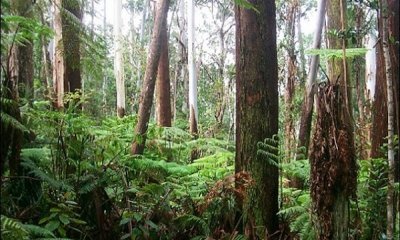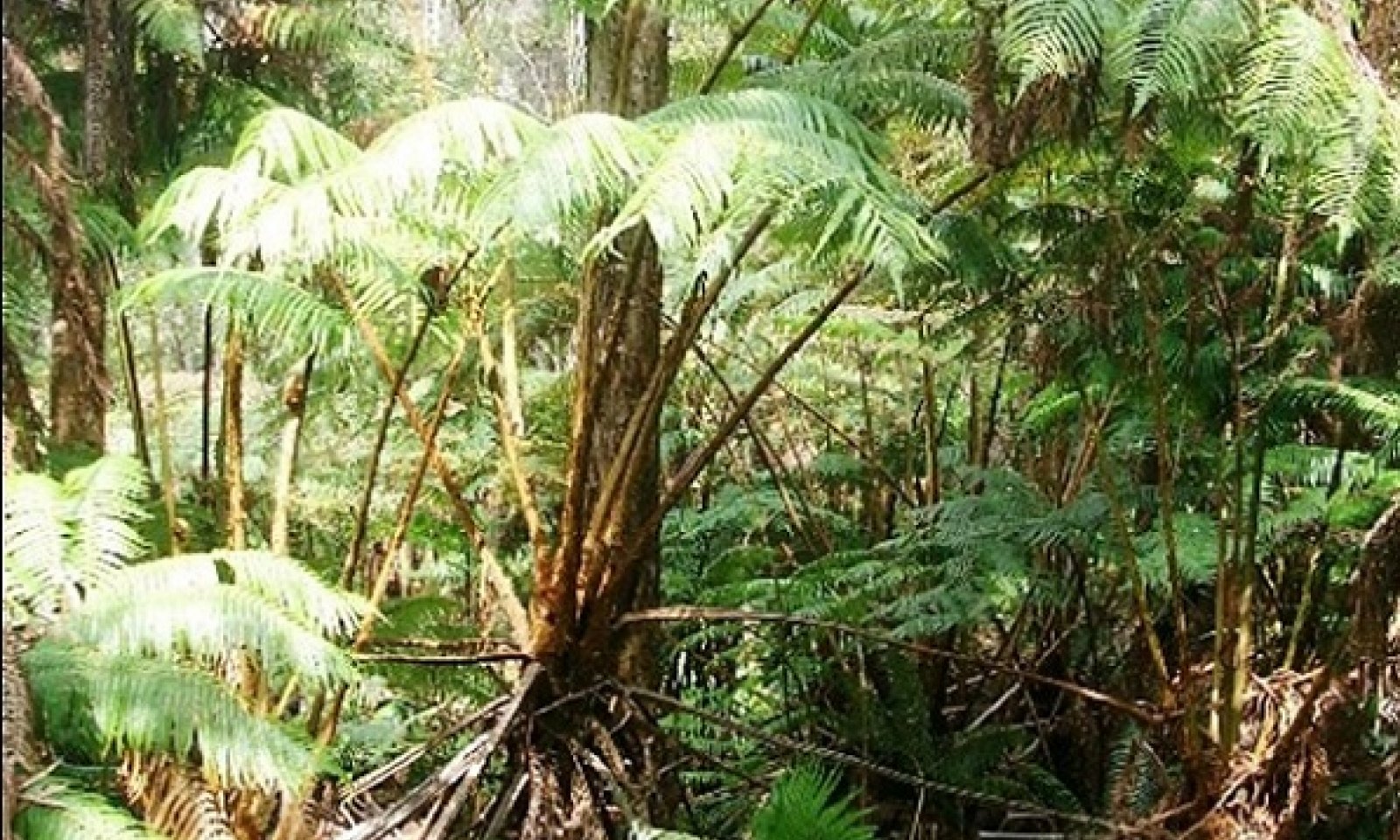
Kona Weather Udic Forest
Scenario model
Current ecosystem state
Select a state
Management practices/drivers
Select a transition or restoration pathway
- Transition T1A More details
- Transition T1B More details
- Transition T1C More details
- Transition T1D More details
- Restoration pathway R2A More details
- Transition T2A More details
- Transition T2B More details
- Restoration pathway R4A More details
- Transition T4A More details
- Transition T4B More details
- Restoration pathway R5A More details
- Restoration pathway R6A More details
-
No transition or restoration pathway between the selected states has been described
Target ecosystem state
Select a state
State 1
Reference State





Description
The Reference State consists of one community phase. Under a regime of natural disturbances, this community has probably been stable through post-glacial time frames and from a broad-scale spatial perspective. Rainfall and temperature vary based on elevation, while substrate varies by lava flow type (aa versus pahoehoe) and age. This produces a matrix of natural variability that changes over a scale of decades and centuries as soils and vegetation communities develop. Overlaid on this matrix are more localized variations caused by wind throw, tree death, and propagule availability. New lava flows bring about a return to primary succession that proceeds at different rates due to lava type and climate.
Much of this ecological site has been cleared for livestock grazing, either mechanically or simply by allowing livestock to graze and browse the native understory. This represents a transition to State 2 Naturalized Grassland. Clearing the forest and then planting introduced timber tree species results in a transition to either State 3 Tree Plantation with Exotic Understory or State 6 Tree Plantation with Native Understory, depending on local availability of seeds for native or invasive introduced species. Gradual invasion by introduced species into existing forest results in State 4 Native Forest with Invaded Understory.
Submodel
State 2
Naturalized Grassland State
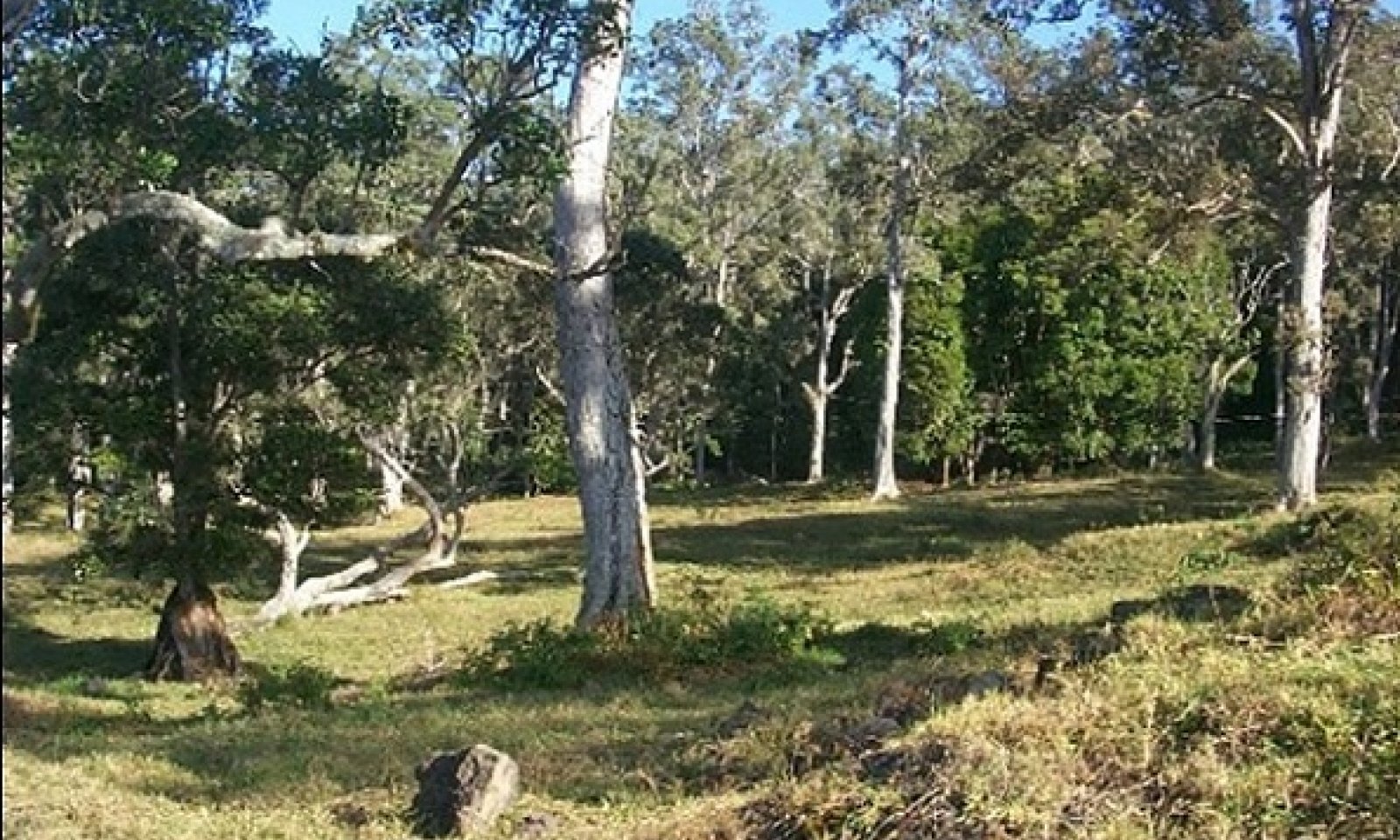



Description
This state is comprised of three community phases that may or may not have an open canopy of remnant native trees (usually ohia lehua but sometimes koa). Koa may occur in or on the edges of grasslands on soils that do not usually contain koa as part of the original forest. These trees may be opportunistic individuals that have taken advantage of increased light and survived browsing long enough to reach maturity.
Trees in these grasslands provide shade and protection from the elements to livestock. However, very little regeneration of trees occurs, so the trees will eventually die out. Community phase 2.1 usually consists of kikuyugrass (Pennisetum clandestinum) and/or pangolagrass (Digitaria eriantha) with an admixture of common vetch (Vicia sativa) or desmodium (Desmodium spp.). Continuous grazing that does not allow favored forage species time to recover from defoliation results in community phase 2.2, which is dominated by lower value forage species but contains enough remnant kikuyugrass to allow for a transition back to community phase 2.1 with prescribed grazing. Longer-term continuous grazing leads to community phase 2.3, which consists of low value grass species and increasing cover of weedy shrubs and vines. Improvement of this community phase requires weed control and restoration of desirable grasses in addition to prescribed grazing.
Submodel
Description
This state has its origin in sites that were cleared of native forest in the mid- to late-20th century and planted to exotic timber species that were considered to be more valuable and useful than native forest species. More recently, previously cleared areas have been planted to timber species. In either case, invasion of the understory by weedy introduced species is a likelihood in most locations.
Once established, this state has little or no tendency to transition to another state.
Submodel
State 4
Native Forest with Invaded Understory State
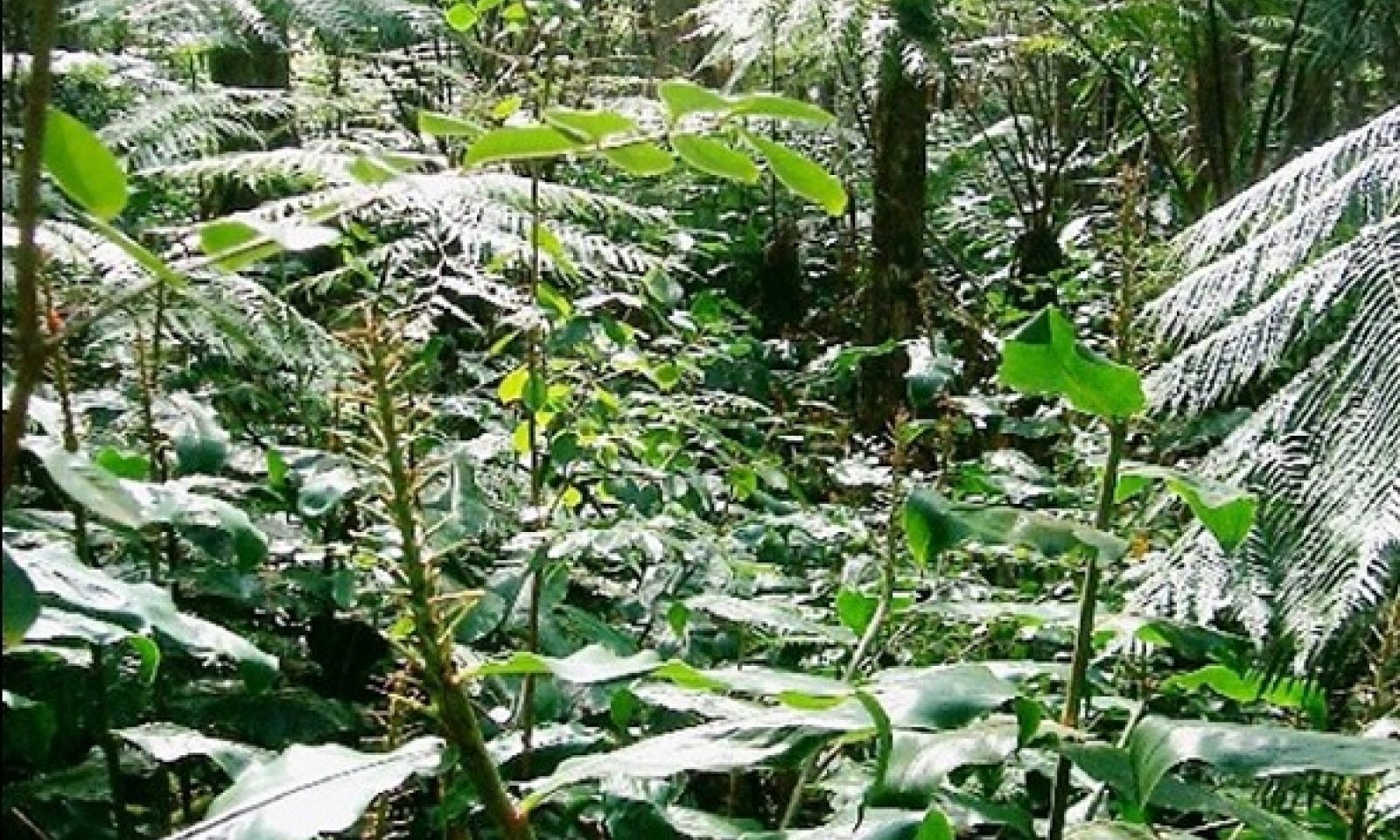



Description
This state consists of one community phase. It arises by invasion by introduced species of intact native forest (the Reference State) or, in some cases, of native overstory stands from which the original understory has been cleared. Native species are unable to regenerate in the highly competitive understory of introduced plants and eventually die out. With time, large introduced tree species will emerge to replace the native overstory trees and form a new overstory. When this last step has occurred, the site will have transitioned to State 5, Invaded Overstory and Understory State.
Disturbance of the soil and direct damage to native understory plants by introduced ungulates, particularly pigs and cattle, will speed the transition to this state by killing native plants and by creating better germination sites for introduced species.
Restoration to the Reference State or a facsimile of it is possible by fencing the site, removing all ungulates, applying herbicides, and replanting native species when needed. Restoration efforts will be affected by the degree of invasion by introduced species and by the particular species that have invaded the site. Long term weed management and fence maintenance will be necessary.
Submodel
Description
This state is comprised of one community phase dominated by introduced species in both the overstory and understory. Remnant individuals of a few native species may persist. This state might be considered a dead end as far as further succession or transition to another state.
Restoration to a facsimile of the Reference State could probably be done with expensive and intensive practices followed by long-term weed management. The site would need to be cleared of all vegetation except any remnant native species, which essentially would represent a transition to State 2 Grassland. From State 2, further restoration could be pursued to State 1 Reference. Clearing of the site followed by establishment of an overstory of noninvasive, introduced timber trees with a native understory as an intermediate step to native forest restoration may be done.
Submodel
Description
This state is comprised of one community phase dominated by introduced timber or native koa trees. It results from clearing the original native forest, often without fundamentally altering the soil, and planting introduced trees or koa. When the surrounding area remains as native forest with few weeds, native species gradually repopulate the plantation site.
This state has its origin in sites that were cleared of native forest in the mid- to late-20th century and planted to exotic timber species that were considered to be more valuable and useful than native forest species. Some of these plantations were deep in the native forest and so not near major sources of introduced weeds.
Submodel
Mechanism
State 1, Reference State, can transition to State 2, Naturalized Grassland, by clearing the forest with heavy machinery or by gradual clearing by allowing cattle access to the forest. Cattle eventually eat or destroy understory ferns, forbs, shrubs, and saplings, opening up the forest so that forage grasses will thrive. On lava substrates, underlying lava rock often is ripped and crushed by heavy machinery to produce Udarents (sandy, organic) soils. Ripping and crushing produces some fine mineral particles and small, abundant gaps between the rock fragments. However, about 50% of the soil organic matter may be lost in the process due to exposure to air and higher temperatures.
Mechanism
State 1 Reference State can transition to State 3 Tree Plantation with Exotic Understory by mechanical removal of the original forest overstory and understory followed by planting of introduced timber species or koa. This practice was common in Kona in the mid-20th century. When the surrounding area is infested with introduced weeds such as Koster’s curse (Clidemia hirta), strawberry guava (Psidium cattleianum), or kahili ginger (Hedychium gardnerianum), those species will invade the site and dominate the understory unless controlled by herbicides. Restoration of native forest would be difficult but possible in koa plantations.
Mechanism
State 1 Reference State can transition to State 4 Native Forest with Invaded Understory by gradual replacement of the understory by introduced shrubs, vines, and small trees that outcompete the native understory species. This process is accelerated by foraging by ungulates and rodents that disturbs the soil surface and directly destroys native plants and prevents their regeneration.
Mechanism
State 1 Reference State can transition to State 6 Tree Plantation with Native Understory by mechanical removal of the original forest overstory and understory followed by planting of introduced timber species or koa. This practice was common in Kona in the mid-20th century. When the surrounding area contains native understory species and is fairly weed-free, native plants such as tree ferns, ieie vines, native ferns, and small native trees reestablish themselves beneath the canopies of many exotic timber species. An exception is redwood plantations, which appear to exclude establishment of most native plants. The ultimate plant community that will develop over time is unknown.
Mechanism
It is possible to restore a facsimile of the Reference State from Naturalized Grassland. Weed control must be applied to grass species and the many opportunistic plant species that will invade the site.
Increased shade from trees growing on the site causes a shift from C4 (warm-season) grass dominance (typically kikuyugrass or pangolagrass) to C3 (cool-season) shade-tolerant grasses (typically meadow ricegrass). This meadow ricegrass layer can be almost as dense and detrimental to establishment of native plants as kikuyugrass. Attempts have been made to suppress meadow ricegrass by planting native shrubs and tree ferns that produce dense shade near the ground and litter that covers the grass.
Weed control will be a perpetual process to capture and maintain the site, with the intensity of control depending on the proximity of weed seed sources. Foraging ungulates, both domestic and feral, must be excluded from the restoration site, but domestic ungulates are useful to initially reduce grass cover and afterward to manage vegetation outside the restoration site perimeter. Extensive planting of native species would follow.
On sites where soils have been converted to Udarents by ripping and crushing by heavy machinery, forest restoration may be more problematic due to the dramatically changed soil conditions. Udarents appear to be a very favorable seedbed for alien weeds.
Transition T2A

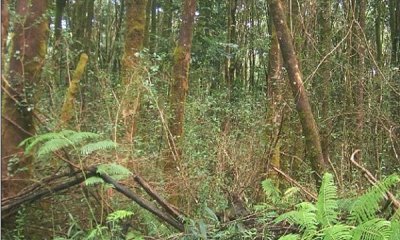
Mechanism
This state may transition to State 3 Tree Plantation with Exotic Understory by herbiciding kikuyugrass, removing ungulates, and then planting introduced timber species. Gradual weed invasion creates an understory dominated by introduced trees, shrubs, grasses, and ferns. It may be possible to develop silvopasture systems that would combine timber production with cattle grazing; this system would control weeds and maintain an understory of introduced forage grasses.
Mechanism
Abandonment of State 2 Naturalized Grassland community 2.3 leads to continued invasion by, and rapid growth of, introduced tree species leading to transition to State 5 Invaded Overstory and Understory.
Mechanism
It is possible to restore a facsimile of State 1 Reference from State 4 Invaded Understory. Before restoration of native plants, introduced understory plants must be eliminated by herbicidal weed control practices, and ungulates must be excluded from the restoration site by a suitable fence. Native species that have been eliminated or greatly reduced in numbers must be restored by replanting. Biodegradable mulch such as cardboard covered with plant litter is very useful for weed control around replanted native species. Long-term control of weeds will be necessary.
Transition T4A


Mechanism
State 4 Invaded Understory State may be restored to State 2 Naturalized Grassland State by mechanical clearing of introduced and remnant native understory plants; native overstory trees may be harvested for timber, destroyed, or left for shade. If leaving large native trees for shade, care must be taken to not damage near-surface roots within about 20 feet (6 meters) of the trees. Introduced pasture grasses may then be seeded or sprigged into the site. Herbicide applications will be necessary before and during pasture establishment to control reemerging weed species.
Transition T4B


Mechanism
The large native ohia lehua and koa trees that form the overstory of State 4 Invaded Understory State are unable to successfully regenerate due to the very dense, shady understory of introduced species. Eventually the large native trees die and are replaced by introduced tree species, which is a transition to State 5 Invaded Overstory and Understory.
Restoration pathway R5A


Mechanism
State 5 Invaded Overstory and Understory may be restored to State 2 Naturalized Grassland by mechanical clearing of overstory and understory vegetation. Introduced forage grasses may then be seeded or sprigged into the site. Herbicide applications will be necessary before and during establishment of grasses to control reemerging weed species.
Mechanism
Where the overstory is koa, it is probable that this state would eventually return to State 1 Reference if not harvested. Where the overstory consists of introduced tree species, some of which successfully reproduce in the understory, the eventual trajectory of this plant community is unknown.
Model keys
Briefcase
Add ecological sites and Major Land Resource Areas to your briefcase by clicking on the briefcase (![]() ) icon wherever it occurs. Drag and drop items to reorder. Cookies are used to store briefcase items between browsing sessions. Because of this, the number of items that can be added to your briefcase is limited, and briefcase items added on one device and browser cannot be accessed from another device or browser. Users who do not wish to place cookies on their devices should not use the briefcase tool. Briefcase cookies serve no other purpose than described here and are deleted whenever browsing history is cleared.
) icon wherever it occurs. Drag and drop items to reorder. Cookies are used to store briefcase items between browsing sessions. Because of this, the number of items that can be added to your briefcase is limited, and briefcase items added on one device and browser cannot be accessed from another device or browser. Users who do not wish to place cookies on their devices should not use the briefcase tool. Briefcase cookies serve no other purpose than described here and are deleted whenever browsing history is cleared.
Ecological sites
Major Land Resource Areas
The Ecosystem Dynamics Interpretive Tool is an information system framework developed by the USDA-ARS Jornada Experimental Range, USDA Natural Resources Conservation Service, and New Mexico State University.

